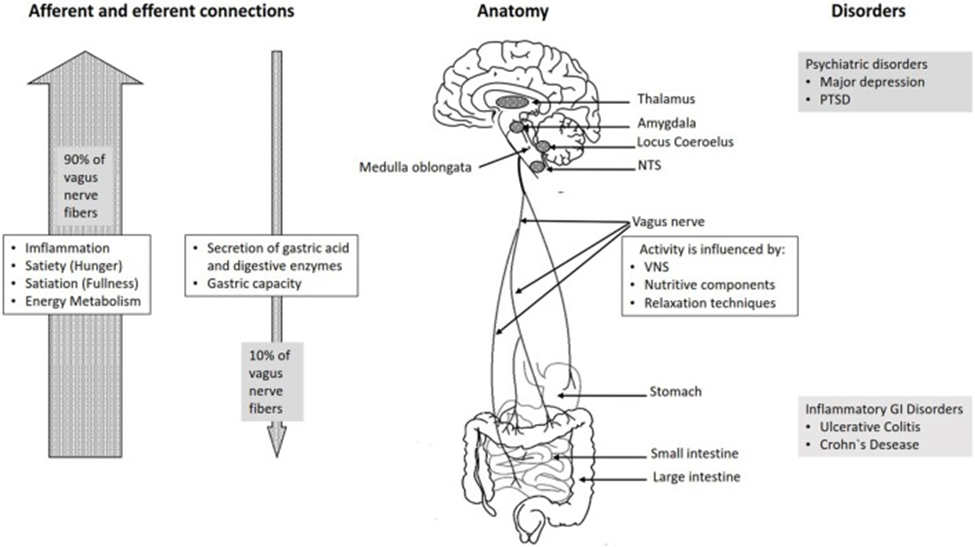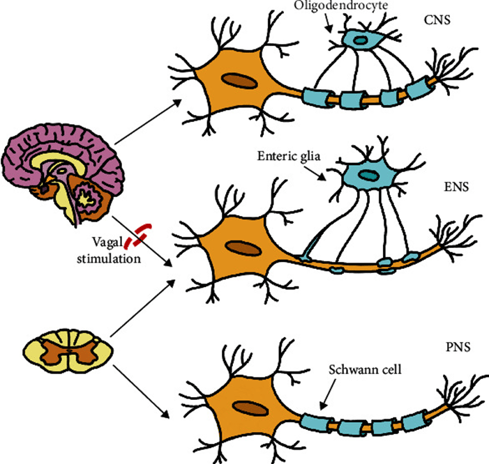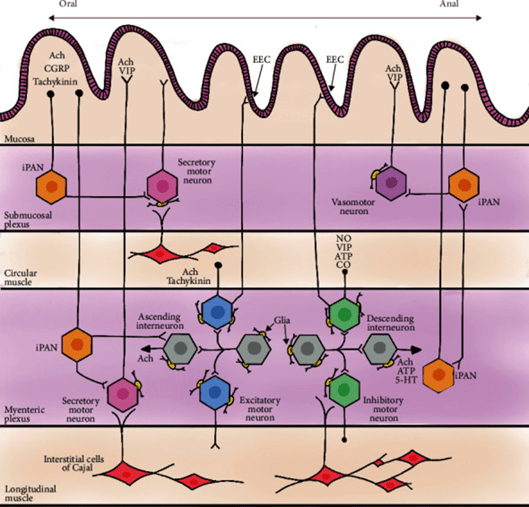The Vagus Nerve and its Functions
The main component of the parasympathetic nervous system is the vagus nerve, which connects the brain and the gut. The parasympathetic nervous system regulates or impacts mood, immunity, digestion, and heart rate, which is crucial to these vital systems' balance and function. The vagus nerve itself regulates digestion, heart rate, respiratory rate, vasomotor activity, and reflex actions, including sneezing, coughing, swallowing, and vomiting. It carries information to the brain from various organs, including the gut, liver, heart, and lungs.
The vagus nerve can also analyze food and nutrients in the gut, storage, and circulation, impacting nutrient absorption rate, storage, and mobilization. Receptors within the vagus nerve interact with cholecystokinin, ghrelin, and leptin, regulating short-term feelings of hunger and satiety.
Basic anatomy and functions of the vagus nerve

Source: Breit, Sigrid et al. “Vagus Nerve as Modulator of the Brain-Gut Axis in Psychiatric and Inflammatory Disorders.” Frontiers in psychiatry vol. 9 44. 13 Mar. 2018, doi:10.3389/fpsyt.2018.00044 This is an open-access article distributed under the terms of the Creative Commons Attribution License (CC BY)
The parasympathetic, sympathetic, and enteric nervous systems are branches of the autonomic nervous system.
Parasympathetic activities (“rest and digest”)
- Dilatation of blood vessels and bronchioles
- Increased bowel motility and glandular secretions
- Stimulation of salivary glands
Sympathetic activities (“fight or “flight”)
- Constriction of blood vessels and intestinal and urinary sphincters
- Decreased intestinal activity
- Dilation of bronchioles
- Increase in heart rate
Enteric activities: (known as the “second brain” or the “gut’s brain”)
- The ENS is similar to the brain in structure and function and contains 100-500 million neurons
- Regulates major enteric processes, including
- Communicates with the vagus nerve
- Epithelial secretion of fluids, ions, and bioactive peptides
- Immune response
- Nutrient detection
- Microvascular circulation
- Motility
Layers of the small intestine
This drawing of the small intestine layers shows the complex ENS network, differentiated cells, and neurotransmitters. iPAN: intrinsic primary afferent neuron; EEC: enteroendocrine cell; Ach: acetylcholine; CGRP: calcitonin gene-related peptide; VIP: vasoactive intestinal peptide; ATP: adenosine triphosphate; NO: nitric oxide; CO: carbon monoxide; 5-HT: serotonin.
Source: Fleming, Mark A 2nd et al. “The Enteric Nervous System and Its Emerging Role as a Therapeutic Target.” Gastroenterology research and practice vol. 2020 8024171. 8 Sep. 2020, doi:10.1155/2020/8024171 This is an open access article distributed under the Creative Commons Attribution License
The gut-brain axis
The vagus nerve is an inherent component of the gut-brain axis, including the brain, spinal cord, autonomic nervous system, and hypothalamic-pituitary-adrenal HPA axis. The HPA axis regulates the adaptive response of an organism to any stressor. It can be activated/regulated by the vagus nerve, triggered by environmental stress and systemic proinflammatory cytokines. It can ultimately promote excess cortisol, the stress hormone that affects the brain, muscles, bones, and body fat.
The sympathetic, endocrine, immune, and humoral systems and the gut microbiota influence the gut-brain axis. Due to its immunomodulatory function, the vagus nerve is pivotal in the relationship between the gut, brain, and inflammation.
The gut-brain axis not only regulates GI and physiological homeostasis but connects the emotional and cognitive areas of the brain to gut functions, including immune activation, intestinal permeability, enteric reflex, and enteroendocrine signaling.
The enteric nervous system (ENS) produces dozens of neurotransmitters as well as hormones and peptides that cross the blood-brain barrier (BBB) and work together with the vagus nerve. For example, ghrelin produced by the ENS crosses the BBB and helps regulate appetite and food intake. Serotonin produced in the gut stimulates peristalsis and can induce nausea and vomiting by interacting with the vagus nerve.
Several factors, including probiotics, gluten, antioxidants, and antibiotics, can affect the vagus nerve via interaction with the gut microbiota, though these effects can vary between individuals.
Improving the tone of the vagus nerve
Maintaining a healthy vagal tone promotes better stress management and resilience. At the same time, impairment of the vagus nerve can play a role in the development of psychiatric disorders, obesity, stress-related disorders, and inflammatory diseases.
Deep breathing, yoga, and meditation can improve vagal tone. Mindfulness training and loving-kindness meditation promote positive emotions by improving vagal tone. Such meditations benefit individuals suffering from anxiety, depression, and chronic pain. Yoga-based therapies and breathing techniques can stimulate the vagus nerve and improve tone. Stimulating the vagus nerve can be therapeutic, relaxing, and anti-inflammatory.
Vagus nerve stimulation may benefit
- Inflammatory bowel disease (IBD)
- Mood and anxiety disorders
- Post-traumatic stress disorder
- Seizures, convulsions
- Stress management
- Treatment-refractory depression
Similarities and differences of the ENS, CNS, and PNS and their supportive cells.

CNS: central nervous system; ENS: enteric nervous system; PNS: peripheral nervous system. The gastrointestinal (GI) tract is innervated by an extensive intrinsic network of ganglion-rich nerve connections known as the enteric nervous system (ENS) [1, 2]. The human ENS contains approximately 400-600 million neurons…
Source: Fleming, Mark A 2nd et al. “The Enteric Nervous System and Its Emerging Role as a Therapeutic Target.” Gastroenterology research and practice vol. 2020 8024171. 8 Sep. 2020, doi:10.1155/2020/8024171 This is an open access article distributed under the Creative Commons Attribution License
Reference
Breit, Sigrid et al. “Vagus Nerve as Modulator of the Brain-Gut Axis in Psychiatric and Inflammatory Disorders.” Frontiers in psychiatry vol. 9 44. 13 Mar. 2018, doi:10.3389/fpsyt.2018.00044 This is an open-access article distributed under the terms of the Creative Commons Attribution License (CC BY)








